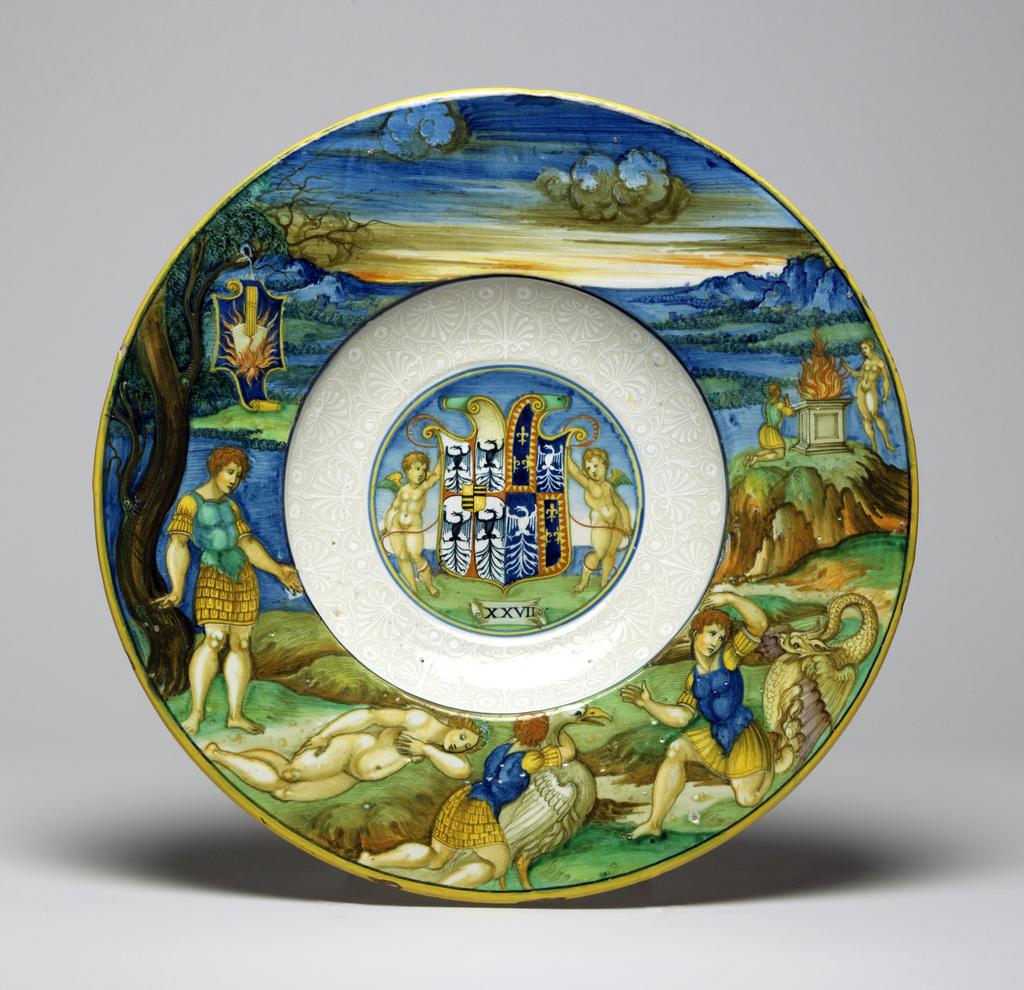Maiolica. Dish from the Isabella d'Este Service. Nicola di Gabriele Sbraghe da Urbino (Italian, d.1537/38). Shape 56. circular with broad, almost flat rim, and deep well; the underside of the rim moulded with three bands of reeding. In the well, within narrow blue and yellow concentric circles, two putti support a shield charged with the arms of Gonzaga impaling Este: argent, a cross patty gules cantoned by four eagles displayed sable (Gonzaga modern granted 1433), an escutcheon overall, quarterly, 1, 4, gules a lion rampant argent (Bohemia), 2, 3, barry of six or and sable (Gonzaga ancient) impaling Este, quarterly, 1, 4, azure three fleurs-de-lis or a bordure indented gules, 2, 3, azure an eagle displayed argent (gules shown orange throughout). Below on a scroll is the impresa `XXVII'. The sides are decorated in bianco sopra bianco with palmettes and scrolls, and a blue line encircles the shoulder. The rim is decorated with Peleus and Thetis. Peleus stands beneath a tree, gazing at Thetis, who sleeps nude on the ground in front of him. Further to the right she is transformed into a swan-like bird as he embraces her, and then into a dragon from which he turns away in horror. Higher up on the right, a goddess appears to Peleus who kneels before an altar. In the distance there is a mountainous landscape and sky. Suspended from the tree there is a shield of testa di cavallo form charged with the impresa of gold rods in a crucible surrounded by flames in a blue ground. Earthenware, tin-glazed overall; the reverse pale beige and speckled. Painted in blue, green, yellow, orange, stone, brown, manganese-purple, black, and white high-temperature (metallic oxide) colours, height, whole, 3.9 cm, diameter, rim, 30.2 cm, circa 1524-1525. Renaissance. Notes: The figures were derived from a woodcut illustration in Giovanni dei Bonsignori's Ovidio methamorphoseos vulgare, Venice (Giovanni Rosso da Vercelli for Lucantonio Giunta), 1497 or a later edition.
Image data
- Accession Number: EC.30-1938
- Photograph copyright © The Fitzwilliam Museum, Cambridge.
- Aperture: f/32.0
- Focal length: 120
- Camera: Hasselblad H3DII-31
- Photographer name: Katie Young
- Image height: 1021 pixels
- Image width: 1024 pixels
- Processed with: Adobe Photoshop Lightroom 5.6 (Macintosh)
- Filesize: 350.41kB
- Exposure time: 1/125
- ISO Speed: 100
- Fnumber: 32/1
Key words
16th Century
Artist/Maker
Artistic Movement
Date
Department
Fitz_AA
High Renaissance
Isabella d'Este
Italian
Material
Medium
Nationalities
Nicola di Gabriele Sbraghe da Urbino
Object Type
Other Keywords
Ovid
Peleus
People
Renaissance
Umbrian School
Workflow
_WF_AdOK
_WF_KWD
_WF_OPACtd
_WF_PCtd
arms
birds
cherubs
circular
coat of arms
crest
crucible
dish
dragons
earthenware
family crest
female
female nude
fire
flames
glazed
goddess
gods
heraldic
heraldry
maiolica
metamorphoses
mythological
mythology
nude
painted
palmettes
polychrome
pottery
putti
putto
round
shield
swans
thrown
tin-glazed
turned
winged
wings




